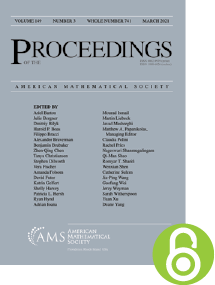A remark on Mahler’s compactness theorem
HTML articles powered by AMS MathViewer
- by David Mumford PDF
- Proc. Amer. Math. Soc. 28 (1971), 289-294 Request permission
Abstract:
We prove that if $G$ is a semisimple Lie group without compact factors, then for all open sets $U \subset G$ containing the unipotent elements of $G$ and for all $C > 0$, the set of discrete subgroups $\Gamma \subset G$ such that (a) $\Gamma \bigcap U = \{ e\}$, (b) $G/\Gamma$ compact and measure $(G/\Gamma ) \leqq C$, is compact. As an application, for any genus $g$ and $\varepsilon > 0$, the set of compact Riemann surfaces of genus $g$ all of whose closed geodesics in the Poincaré metric have length $\geqq \varepsilon$, is itself compact.References
-
J. W. S. Cassels, An introduction to the geometry of numbers, Springer-Verlag, Berlin, 1959. MR 28 #1175.
- Claude Chabauty, Limite d’ensembles et géométrie des nombres, Bull. Soc. Math. France 78 (1950), 143–151 (French). MR 38983, DOI 10.24033/bsmf.1412
- D. A. Každan and G. A. Margulis, A proof of Selberg’s hypothesis, Mat. Sb. (N.S.) 75 (117) (1968), 163–168 (Russian). MR 0223487
- André Weil, On discrete subgroups of Lie groups, Ann. of Math. (2) 72 (1960), 369–384. MR 137792, DOI 10.2307/1970140
- A. M. Macbeath, Groups of homeomorphisms of a simply connected space, Ann. of Math. (2) 79 (1964), 473–488. MR 160848, DOI 10.2307/1970405
Additional Information
- © Copyright 1971 American Mathematical Society
- Journal: Proc. Amer. Math. Soc. 28 (1971), 289-294
- MSC: Primary 22.20
- DOI: https://doi.org/10.1090/S0002-9939-1971-0276410-4
- MathSciNet review: 0276410


